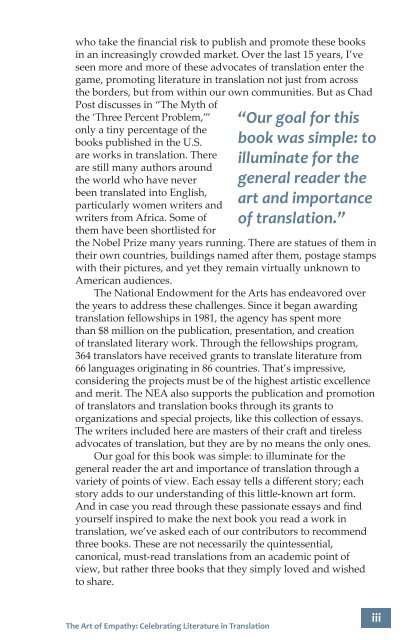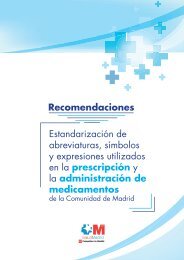lKd7nD
lKd7nD
lKd7nD
Create successful ePaper yourself
Turn your PDF publications into a flip-book with our unique Google optimized e-Paper software.
who take the financial risk to publish and promote these books<br />
in an increasingly crowded market. Over the last 15 years, I’ve<br />
seen more and more of these advocates of translation enter the<br />
game, promoting literature in translation not just from across<br />
the borders, but from within our own communities. But as Chad<br />
Post discusses in “The Myth of<br />
the ‘Three Percent Problem,’”<br />
only a tiny percentage of the<br />
books published in the U.S.<br />
are works in translation. There<br />
are still many authors around<br />
the world who have never<br />
been translated into English,<br />
particularly women writers and<br />
writers from Africa. Some of<br />
them have been shortlisted for<br />
“Our goal for this<br />
book was simple: to<br />
illuminate for the<br />
general reader the<br />
art and importance<br />
of translation.”<br />
the Nobel Prize many years running. There are statues of them in<br />
their own countries, buildings named after them, postage stamps<br />
with their pictures, and yet they remain virtually unknown to<br />
American audiences.<br />
The National Endowment for the Arts has endeavored over<br />
the years to address these challenges. Since it began awarding<br />
translation fellowships in 1981, the agency has spent more<br />
than $8 million on the publication, presentation, and creation<br />
of translated literary work. Through the fellowships program,<br />
364 translators have received grants to translate literature from<br />
66 languages originating in 86 countries. That’s impressive,<br />
considering the projects must be of the highest artistic excellence<br />
and merit. The NEA also supports the publication and promotion<br />
of translators and translation books through its grants to<br />
organizations and special projects, like this collection of essays.<br />
The writers included here are masters of their craft and tireless<br />
advocates of translation, but they are by no means the only ones.<br />
Our goal for this book was simple: to illuminate for the<br />
general reader the art and importance of translation through a<br />
variety of points of view. Each essay tells a different story; each<br />
story adds to our understanding of this little-known art form.<br />
And in case you read through these passionate essays and find<br />
yourself inspired to make the next book you read a work in<br />
translation, we’ve asked each of our contributors to recommend<br />
three books. These are not necessarily the quintessential,<br />
canonical, must-read translations from an academic point of<br />
view, but rather three books that they simply loved and wished<br />
to share.<br />
The Art of Empathy: Celebrating Literature in Translation<br />
iii



